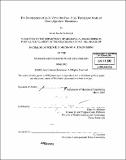The development of an in vitro, one-pass, high-throughput model of flow dependent thrombosis
Author(s)
Echenique, Javier Jacobo
DownloadFull printable version (3.339Mb)
Other Contributors
Massachusetts Institute of Technology. Dept. of Mechanical Engineering.
Advisor
Elazer R. Edelman.
Terms of use
Metadata
Show full item recordAbstract
Thrombosis is an initiating response to a vascular injury, which aids in the repair and remodeling of the vessel wall. However, if this process remains unchecked, occlusion of the arterial lumen may quickly occur. The arterial vascular bed is a delicate and life-sustaining environment, in which a pathological thrombosis can bring about devastating conclusions such as acute vascular syndromes or post-interventional thrombosis. In order to explore these flow-dependent thrombotic reactions, it is essential to consider the physical environment present inside the vasculature. A novel in vitro, high-throughput method for creating one-pass blood flows has been developed to model the arterial environment. Flow is generated in a matrix of small glass tubes with varying inner diameters through the use of a constant pressure drop. Using this technique, a variety of flow rates are created in the numerous tubes, resulting in a variety of flow shear rates. In addition, this technique allows for the monitoring of sensitive, flow-dependent processes without the disturbances from pump action and circuit effects. A detailed discussion about the goals of the proposed systems is included, as well as the methodology employed to choose the optimal flow system, and the process by which the components of the system evolved in design. (cont.) Finally, tests are formulated in order to explore the issues of biological feasibility, noise, precision, and accuracy related to the proposed system and make to make improvements on the design accordingly.
Description
Thesis (S.B.)--Massachusetts Institute of Technology, Dept. of Mechanical Engineering, 2005. Includes bibliographical references (leaves 43-46).
Date issued
2005Department
Massachusetts Institute of Technology. Department of Mechanical EngineeringPublisher
Massachusetts Institute of Technology
Keywords
Mechanical Engineering.